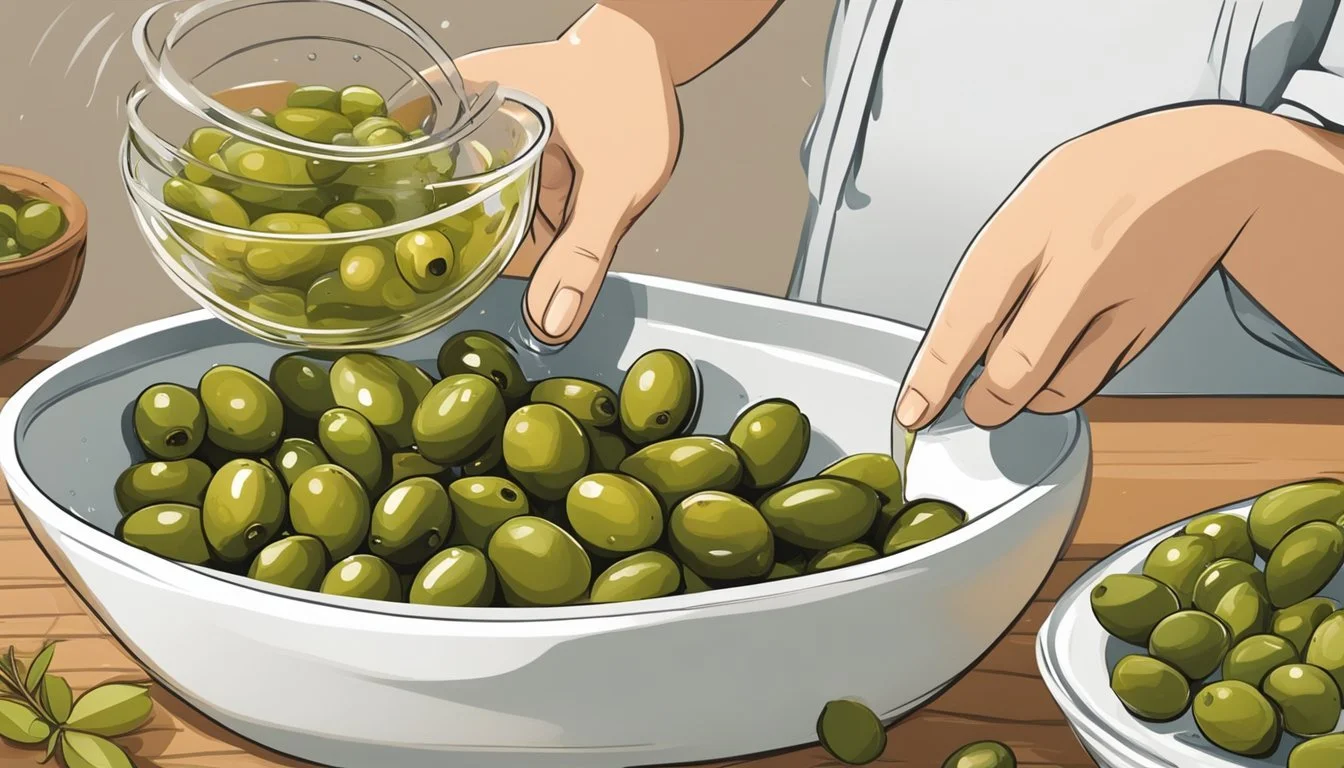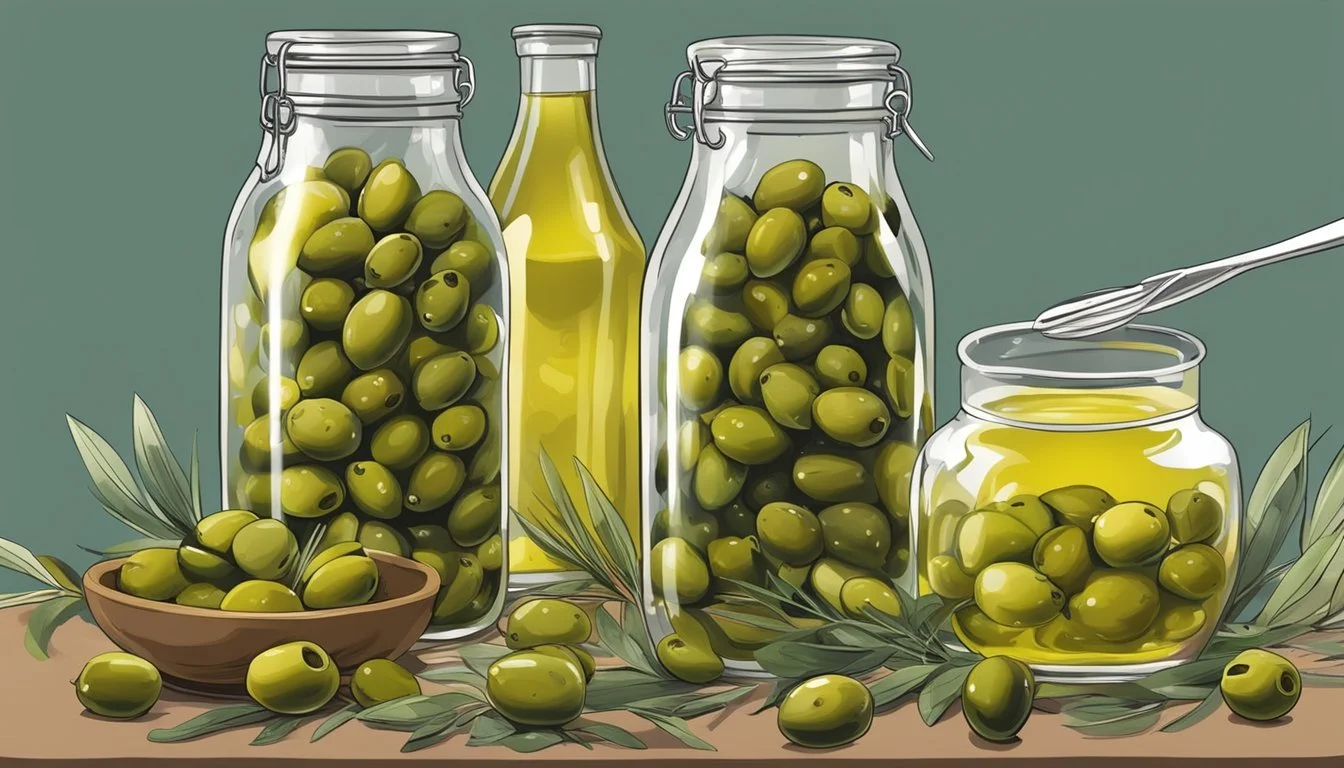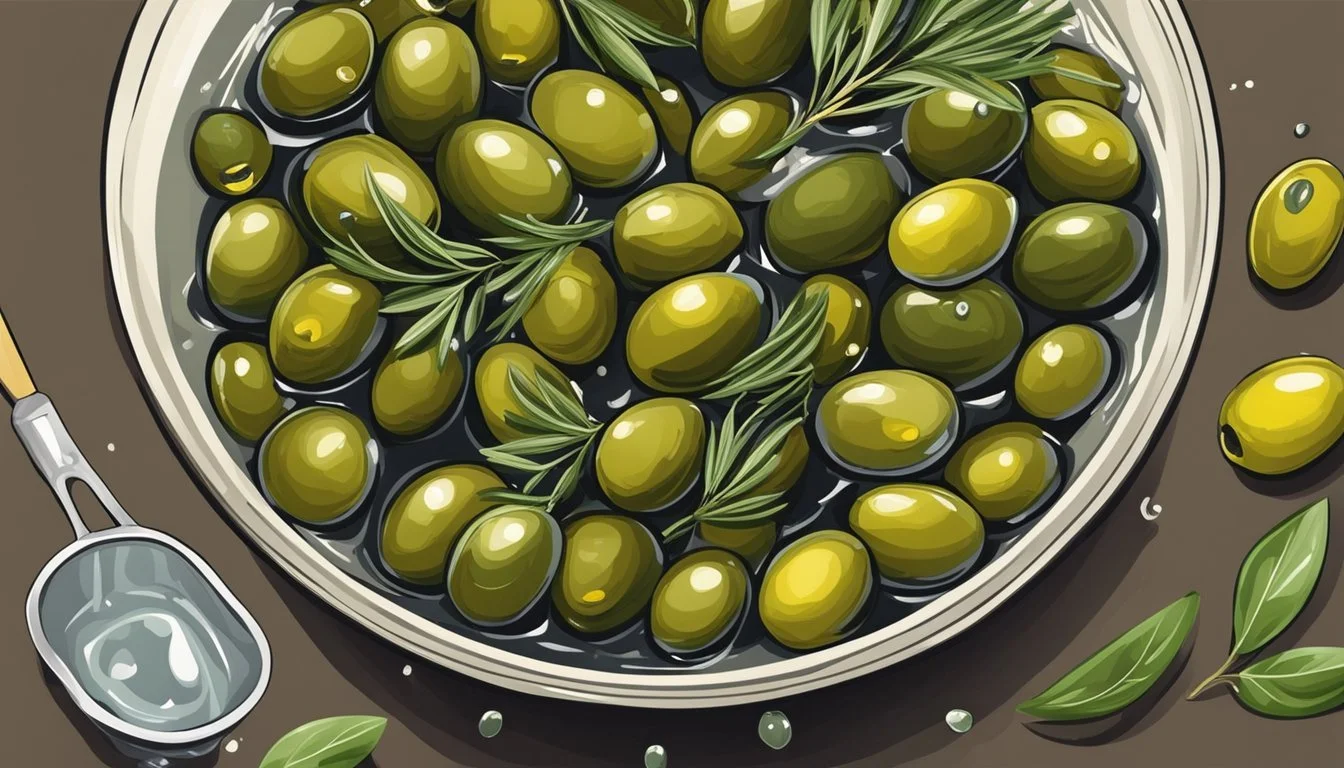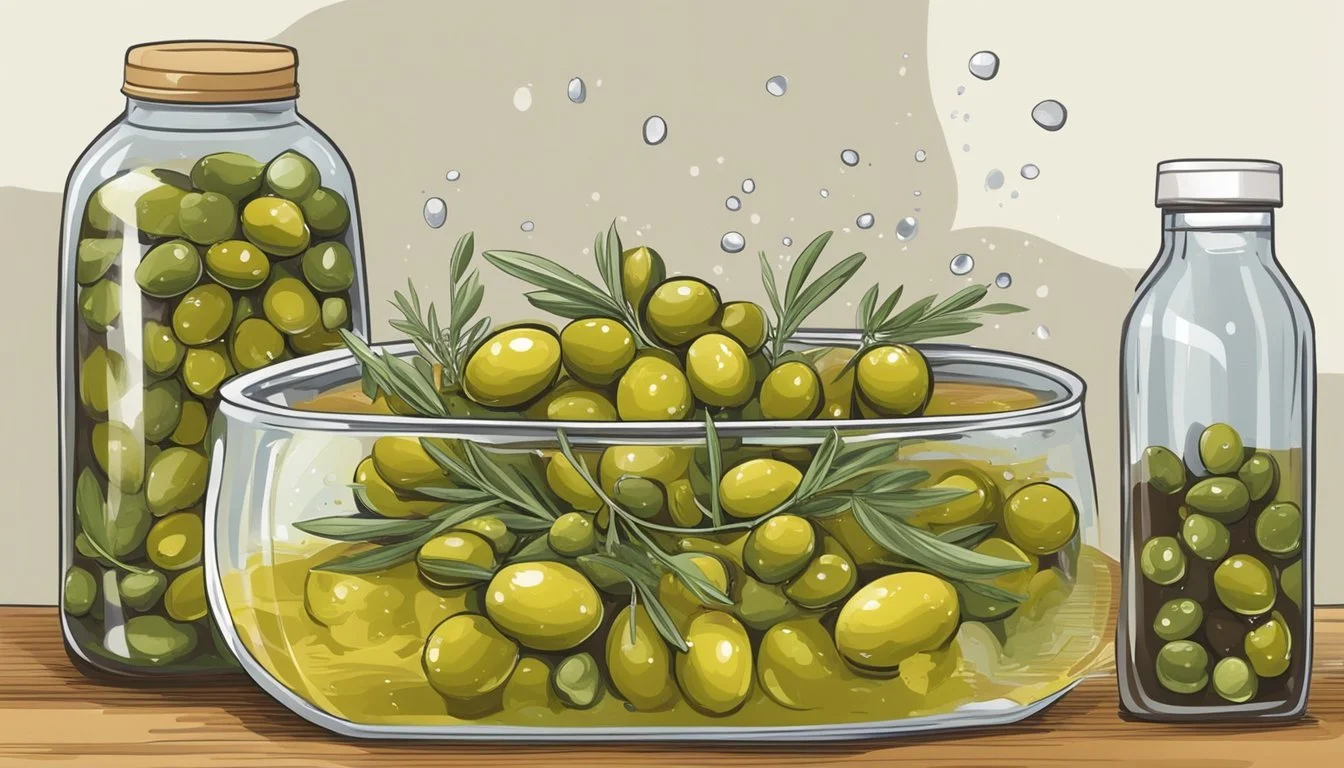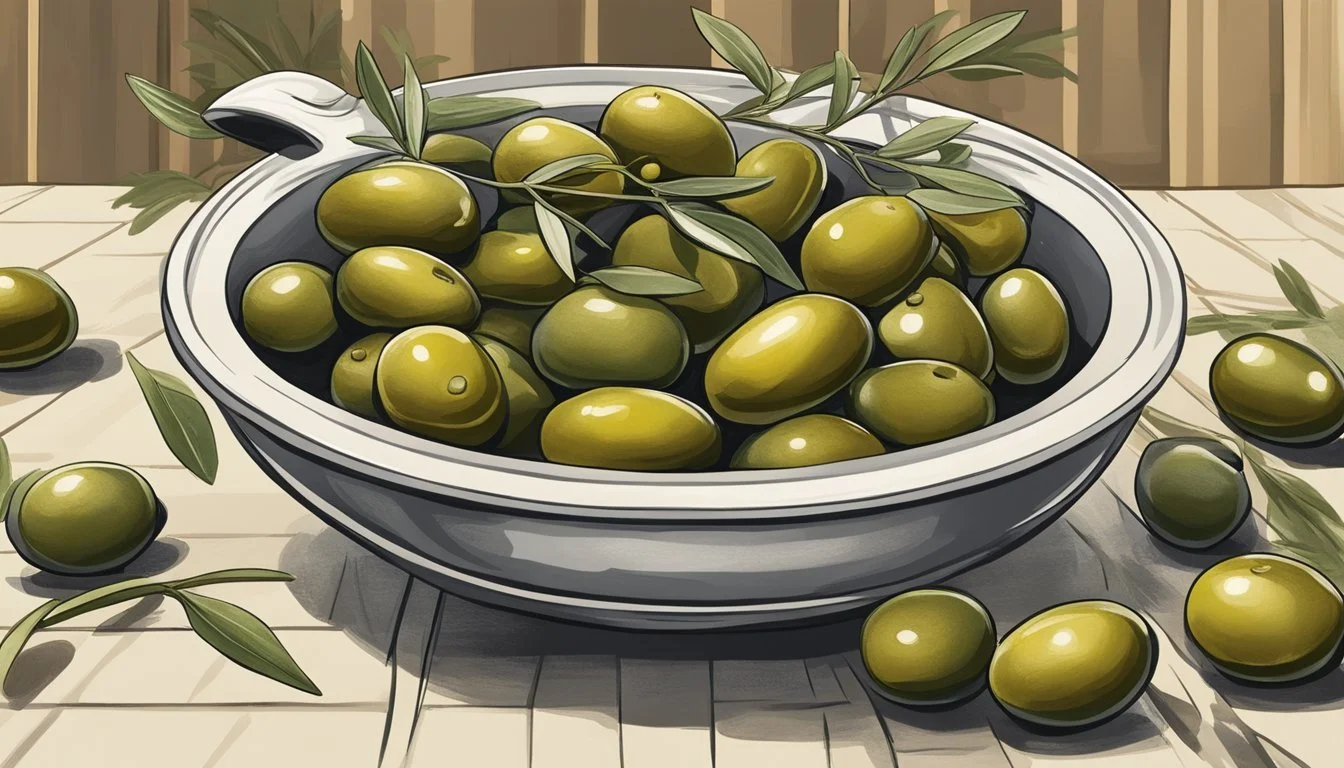Fixing Overly Salty Olives
Master Rinsing and Marinating Techniques to Enhance Flavor
Olives, (What wine goes well with olives?) a staple in many cuisines, are often preserved in brine, a salty solution that can sometimes leave them tasting excessively salty. While the right amount of salt is crucial for both the preservation process and the flavor enhancement of both green and black olives, an overly salty batch can overpower the palate and mask the fruit's natural flavors. Reducing the sodium content without compromising the olives' cherished taste and texture is a delicate process that can be achieved through specific rinsing and marinating techniques.
When olives emerge from their brine too salty, a simple water rinse can be the first step toward balance. Submerging olives in cold water begins a leaching process, drawing out excess salt. Periodically changing the water and tasting the olives can help gauge the desalination process. In contrast to the initial brining, which imparts salt and a hint of bitterness, a proper rinse paves the way for a more enjoyable olive experience.
After rinsing, marinating provides a method not only to introduce a range of flavors but also to mitigate any residual saltiness. A balanced marinade might include vinegar, which not only brings its own flavor profile but also serves to complement the olives' natural piquancy. The addition of aromatics or herbs to the marinade allows for a custom flavor profile, transforming the olives into a nuanced culinary ingredient or stand-alone delicacy.
Understanding Salinity in Olives
Olives are renowned for their distinct salty flavor, which is integral to their preservation and taste profile. However, the salt content can sometimes exceed desirable levels, impacting not just the culinary experience but also nutritional balance.
Causes of Excess Salt Content
One primary reason for high salt content in olives is their curing process. Olives are inherently bitter and are often fermented in a salt brine to remove this bitterness. Different curing methods and durations can lead to varying levels of saltiness in the final product.
Effects of Salt on Flavor and Texture
Salt has a preservation effect on olives but in excess, it can overpower the subtle flavors. It also affects the texture of the olives; high salt concentration can lead to firmer olives while reducing the salt can soften them. Consumers' preference for saltiness in olives is subjective, yet a balance is key to ensuring the nuances of the olive's natural flavor are not lost.
Nutritional Considerations
While sodium—a component of salt—is essential for human health, too much of it can lead to health issues. Excess salt in olives can contribute to an increased intake of sodium, potentially affecting cardiovascular health. Olives contain other important nutrients like potassium, fiber, and calcium, but the high salt content can detract from these benefits. The goal is to manage the sodium levels without compromising the intake of other nutrients in olives, such as protein, minimal saturated fat, negligible sugar and carbohydrates, which collectively contribute to their nutritional profile.
Preparing to Reduce Salinity
Before attempting to reduce the salinity of olives, it is important to understand that the process involves selecting suitable olives, gathering necessary tools and ingredients, and comprehending the methodology behind the rinsing process.
Selecting the Right Olives
The initial step involves choosing fresh, ripe olives as they respond best to desalination. Olives right off the tree will not contain added salt, whereas those already in a jar may have been brined or cured. It is preferable to start with olives that have not been overexposed to salt to control the seasoning process better.
Tools and Ingredients Needed
One needs the following tools and ingredients to effectively reduce the saltiness of olives:
Jar or Airtight Container: To hold olives during the desalination process.
Large Bowl: Used for rinsing or soaking the olives.
Fresh Water: Essential for the rinsing process to help draw out excess salt.
Garlic Cloves, Rosemary, Oregano, and Other Fresh Herbs: These are optional and used for marinating post-rinsing to infuse the olives with flavors.
Cold Water: Recommended for soaking as it does not cook or overly soften the olives, preserving their texture.
Understanding the Rinsing Process
The rinsing process begins with placing the selected olives in a large bowl and covering them with cold water. The primary goal is to leach out the excess salt by osmosis. It involves refreshing the water multiple times until olives reach the desired level of salinity. Once the salt is reduced, some may choose to marinate the olives with garlic, herbs like rosemary and oregano, or other preferred seasonings in an airtight container to enhance their flavor profile.
Rinsing Techniques
Rinsing techniques offer a practical solution to reduce the salt content in olives, catering specifically to personal preferences for less intense salinity.
Cold Water Rinse
Using fresh water is a simple yet effective method. One places the salty olives into a bowl and submerges them in cold fresh water. This process should be maintained for 30 minutes to an hour, and the water should be replaced every ten minutes to maximize the desalination process. Olives, whether green or black, release some of their salt content into the water, which can be tasted intermittently to assess the change in salinity.
Boiling Water Rinse
A boiling water rinse speeds up the desalination by using heat to draw out salt more quickly. Olives are soaked in boiling water for a few minutes, then drained and rinsed again with hot water. This method may also reduce the bitterness caused by compounds like oleuropein especially in green varieties such as Green Sicilian olives.
Vinegar Solution Soak
A soak in a vinegar solution, which can be prepared by mixing equal parts of vinegar (like apple cider vinegar) and water, offers another option. The acidity from the vinegar, or alternately lemon juice, can help in balancing the saltiness. Immersing the olives in this mixture for an hour can impart a new dimension of flavor while alleviating excess salt.
Flavoring After Desalting
Once olives are desalted, enhancing their flavor becomes an essential step. This process not only restores their palatability but also allows for creative culinary expressions, particularly within Greek and Mediterranean traditions.
Using Olive Oil
A favored choice in the Mediterranean, olive oil, especially extra virgin olive oil, contributes a fruity and rich dimension to the taste profile of olives. To marinate, simply toss the desalted kalamata or green olives in the oil, allowing them to absorb flavor. For an aromatic twist, one can warm the olive oil with garlic before pouring over the olives.
Incorporating Fresh Herbs
Fresh herbs such as thyme lend a herbaceous depth to marinated olives. A classic combination involves gently tossing the olives with thyme and other herbs like rosemary, each releasing their essential oils, which are impeccably absorbed by the olives' meaty texture.
Adding Citrus and Other Flavors
Citrus elements, like lemon peel or orange peel, introduce a zesty brightness to the olives. Adding peels to the marinade infuses the olives with a tangy flavor, which complements the fatty richness of complementary foods, such as feta cheese, present on charcuterie boards. The infusion of such diverse flavors enriches the overall experience.
Marinating Techniques
When marinating olives, the art lies in blending the right flavors while maintaining the integrity of the olives. The marinade serves not only to flavor but also to preserve the olives, creating a delicious combination of tastes.
Creating the Perfect Marinade Mix
The base of any olive marinade begins with extra virgin olive oil; it acts as a carrier for the flavors and adds depth. Now, one must consider the herbs and spices to be used; oregano and rosemary are classic choices that imbue the olives with a distinctly Mediterranean profile. For a punchier kick, garlic can be minced or sliced thinly and added to the mixture. Vinegar adds a bright note, cutting through the richness of the oil—it should be used sparingly to avoid overpowering the other flavors.
A well-rounded marinade might appear as follows:
Extra Virgin Olive Oil: 3/4 cup
Vinegar (balsamic or red wine): 1/4 cup
Garlic: 3 cloves, minced
Oregano: 1 tablespoon, fresh and chopped
Rosemary: 1 tablespoon, fresh and chopped
Mix the ingredients in a mason jar or similar container. Before adding any dry herbs to the oil, they can be gently warmed over medium heat until fragrant to intensify the flavors.
Timing and Temperature Considerations
For the flavors in the marinade to effectively penetrate and enhance the olives, marinating should take place over several hours or even overnight. The olives absorb flavors best when marinated at room temperature, as the oil can solidify when chilled, which may hinder flavor absorption.
The marinating process is not just about infusing flavor; it's also a continuation of the fermentation and brining process that helps preserve the olives. The duration of marinating depends on the desired intensity of flavor. A general guideline for timing might be:
Light flavor: 2-4 hours
Medium flavor: 5-12 hours
Intense flavor: 13-24 hours or more
Always ensure the olives are fully submerged in the marinade to prevent any possible spoilage. Use a plate or weight to keep them under the surface of the liquid.
Once marinated, olives can be stored in the refrigerator for extended periods, often up to a few weeks, provided they are kept in a clean and airtight container. Remember to bring the olives back to room temperature before serving to ensure the oil flows freely and flavors are at their best.
Storing Marinated Olives
Once you've marinated your olives, storing them properly is crucial to maintain their savory flavor and freshness. The key is to ensure that the olives are kept in a cool environment and sealed well to prevent any contamination or spoilage.
Refrigeration Methods
Marinated olives should be stored in the refrigerator to preserve their quality. They can be enjoyed as a snack or appetizer and should be kept in:
Airtight containers: An airtight seal prevents odors from the fridge affecting the olives' flavor.
Glass jars: Ideal for visibility and maintaining the olives’ taste.
Brine or olive oil: The marinade serves as a preservative that keeps the olives moist and flavorful.
Long-term Storage Solutions
For those looking to store marinated olives over an extended period:
Castelvetrano olives, known for their buttery flavor, fare well in refrigerated conditions for up to a month when submerged in their marinade.
Regularly check the brine or olive oil level to ensure olives remain fully submerged.
Consume refrigerated olives within a few months to enjoy their savory qualities at their best.
Serving Suggestions
After successfully adjusting the salt level of your olives, serving them in a manner that complements their flavor is essential. This section provides guidance on pairing with other foods and tips for presentation that can enhance the dining experience.
Pairing with Foods
Olives are versatile and pair well with a variety of foods.
Cheese: A classic choice is mozzarella or pimento for a balance of creamy and salty flavors.
Bread: Serve on toasts as an appetizer; the bread's mildness complements the olives' robust taste.
Salads: Incorporate into recipes for a nutritional boost, providing fiber, vitamin A, and vitamin C.
Proteins: Try paired with roasted olives for a dish rich in monounsaturated and polyunsaturated fats.
Presentation Tips
The way olives are presented can impact their enjoyment.
Bowl Choices: Opt for shallow bowls that allow guests to see and select olives easily.
Add-Ins: Introduce a small bowl of lemon juice, chili, or pickles to accompany and contrast the olives.
Garnishes: Top with fresh herbs, or serve alongside vibrant ingredients like sliced tomatoes to add color and appeal.
Preparation: Consider offering a selection of both fast and slow-marinated olives to provide a variety of flavors and textures.
Health Benefits and Considerations
When addressing the topic of olives, one should consider both the benefits and precautions associated with their nutritional components, such as fats, salt, and other nutrients.
Understanding Fats and Salt Content
Olives are known for their high fat content, with the majority being monounsaturated fat, a healthier fat that can support heart health. However, they do contain smaller amounts of polyunsaturated and saturated fats.
Type of Fat Percentage Monounsaturated Fat High Polyunsaturated Fat Low Saturated Fat Low
The salt content in olives is a result of the curing process necessary to transform fresh olives from the olive tree into the flavorful morsels we enjoy. While sodium, which makes up salt, is essential for bodily functions, it is important to consume it in moderation.
Possible Health Promoting Properties
Olives are a source of vitamins such as vitamin A and vitamin C, which are vital for immune function and vision. They also provide nutrition in the form of minerals like calcium, potassium, and iron, which support bone health, muscle function, and oxygen transport in the blood respectively.
Fiber is another key component, with a significant amount found in olives, promoting digestive health.
Vitamin A: Contributes to good vision and immune function
Vitamin C: Aids in repair of tissues and enzymatic production of certain neurotransmitters
Iron: Essential for blood production
Calcium: Important for bone health and muscle function
Potassium: Helps regulate fluid balance and nerve signals
Oleuropein, a compound found in olives, has been associated with bacteria inhibition and other health-promoting properties. It's also thought to reduce inflammation and oxidative stress, which can prevent chronic diseases.
In summary, while olives are nutritious, individuals should pay attention to their overall fat and sodium intake when consuming them. Those who are concerned about their sodium levels should opt for desalting techniques to enjoy olives healthily.
Cultural and Historical Context
The cultural and historical significance of olives spans thousands of years, rooting deeply in traditional agricultural practices and spreading through an array of global cuisines. Olives have long been treasured not only for their distinct flavors but also for their importance in society and economies across the Mediterranean and beyond.
Traditional Olive Harvesting
In the ancient Mediterranean, particularly in Greek society, the olive tree was revered; it was a symbol of peace, wisdom, and victory. The earliest accounts of olive cultivation date back to the 6th century BCE in regions like Turkey and Greece. Olives were traditionally harvested by hand or with the use of simple wooden tools. Workers employed methods such as beating the branches with sticks or shaking the trees to collect the olives into nets spread below.
Harvesting typically aligned with the autumn season when olives reached optimal ripeness. Methods have evolved, yet in some locales, traditional techniques persist, favoring quality and ensuring minimal damage to the fruit and trees. The harvested olives would then undergo processes like curing and marinating, with additions of fresh thyme or fresh rosemary to enhance the flavors.
Culinary Influence Across Cultures
Olives have made a significant culinary impact across various cultures, extending beyond the Mediterranean to become a staple in cuisines worldwide. Their versatility is showcased in numerous dishes; from being a vital component in a Spanish tapenade to playing a central role in Middle Eastern mezze platters. The flavor profile of olives varies greatly depending on the type, region, and preparation, encompassing a spectrum from bitter and salty to fruity and tangy.
Historically, olives have been a bridge between cultures, merging and adapting different flavours within local diets. This exchange is evident in the widespread use of olive oil, a product of pressed olives, essential in Mediterranean cooking and influential globally. The integration of olives into various culinary traditions underscores their universal appeal and the shared human desire for rich, nuanced flavors.
Conclusion
In the process of adjusting the salinity of brined olives to suit individual taste preferences, several methods have been discussed. First, water soaking is a straightforward and effective method, with the olives being submerged for 30 minutes to an hour to leach out excess salt. One can repeat the process until the desired level of saltiness is achieved.
For those seeking additional flavor, marination offers an appealing alternative. A variety of ingredients can be used to create a custom marinade, balancing the inherent saltiness of the olives with sweet, sour, or herbaceous notes. The marinating process not only infuses the olives with nuanced flavors but can also help in reducing the salty profile.
Crafting a suitable marinade relies on understanding the harmony of flavors. It's recommended to incorporate fresh herbs, citrus zest, or a touch of honey. To ensure the olives absorb these new flavors, they should be marinated for a minimum of a few hours or as long as overnight.
Lastly, should the olives remain excessively salty, incorporating them into a recipe can diffuse the salt through the dish. Finely chopped olives can be used in small doses to season salads, pasta, or as a garnish to introduce a concentrated burst of flavor without overwhelming the palate with salt.
Remember to taste and adjust the seasonings gradually. By using these techniques, one can effortlessly turn overly salty olives into a versatile and flavorful component of numerous culinary creations.



